Asustor Flashstor 6 and Flashstor 12 Pro SSD NAS Review – Worth Your Data?
Asustor has made its mark in the data storage sector with their recently launched Flashstor 6 and Flashstor 12 Pro M.2 SSD NAS devices. These devices are packed with features and an attractive design that aims to cater to the needs of every user out there. But are they worth investing in? We will explore the top five reasons why you should consider adding these devices to your tech arsenal, and in contrast, we will also delve into some aspects that might make you reconsider. Get ready to know all the ins and outs of these promising Asustor devices, as we dissect what makes them a worthy buy, or potentially a pass, for your storage needs.
Asustor Flashtor 6 FS6706T Here on Amazon $499 – HERE
Asustor Flashstor 12 Pro FS6712X Here on Amazon $860 – HERE
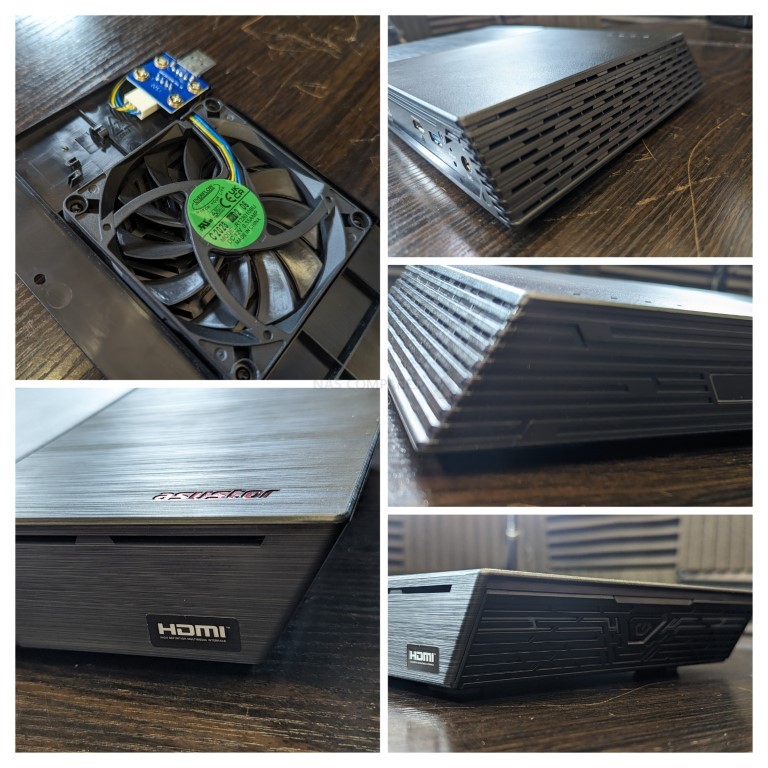
The TL:DR on Whether You Should buy the Asustor Flashstor NAS Series:
The Asustor Flashstor 6 and Flashstor 12 Pro M.2 SSD NAS have compelling reasons to buy, including:
- They possess an aesthetically pleasing, compact chassis that fits between 6 and 12 M.2 NVMe SSDs while maintaining a low operational noise.
- The devices offer impressive audio and visual connectivity, including HDMI 2.0B for increased 4K visual bandwidth performance and an SPDIF audio output.
- The storage capacity is notable with the inclusion of 6-12 M.2 NVMe SSD Bays.
- The inclusive Asustor ADM software, a full NAS operating system, provides a robust management platform.
- The price point is affordable, with the Flashstor 6 and Flashstor 12 Pro priced at $499 and $860 respectively.
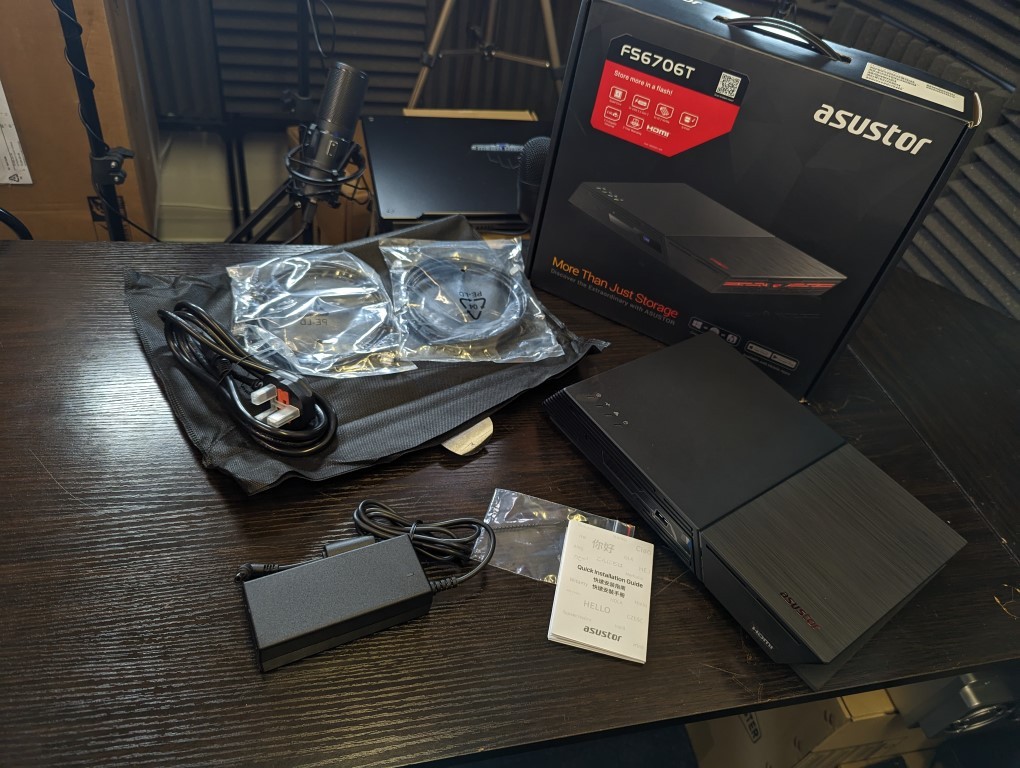
However, they also have downsides:
- The devices use an Intel Celeron N5105 CPU, which might limit performance and connectivity potential.
- The M.2 NVMe SSD slots are PCIe Gen 3 x1, which means each bay will have a 1000 MB/s bottleneck.
- The network connectivity is not optimal for the throughput capability of the SSDs due to CPU limitations.
- The devices lack inclusive heat sinks for the SSDs, which could potentially lead to heat-related issues.
- Asustor was a victim of the DeadBolt ransomware attack in 2022, which may raise questions about the company’s security measures.
Asustor Flashstor 6 and Flashstor 12 Pro M.2 SSD NAS – Reasons You SHOULD Buy?
There are a surprisingly large number of reasons why the Flashstor 6 and 12 Pro are particularly impressive flash NAS systems. Indeed, narrowing it down to 5 was harder than you might think. Nonetheless, the following 5 reasons might well be enough to convince you the new NVMe SSD-focused Asustor NAS deserve your data!
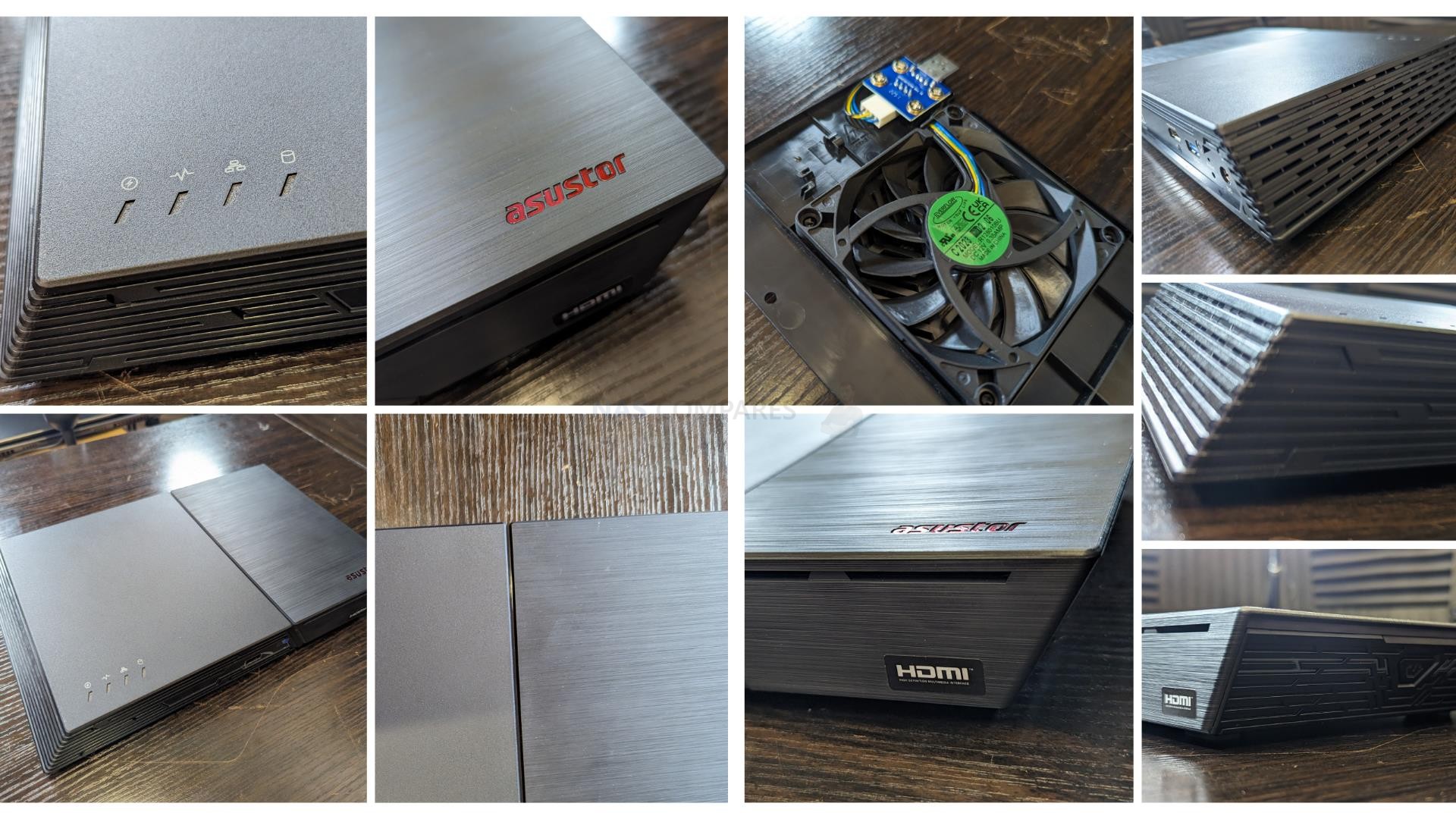
#1. Very, VERY Well Designed Chassis that is also nice to look at!
The design of the Flashstor 12 Pro and Flashstor 6 is probably the thing that impressed me the most when I first heard about this device. The devices arrive in a fantastically compact chassis and the brand deserves credit for managing to squeeze between 6 and 12 M.2 NVMe SSDs into this small space. With numerous ventilation points around the system and an active cooling fan directly beneath the storage media, this system maintains an impressive operational temperature, yet low operational noise at the same time. The physical size of the device is significantly smaller in terms of general desktop footprint and overall volume compared to the average 2-bay or 4-bay NAS device. This means that in terms of overall impact and design, the Flashstor 6 and Flashstor 12 Pro are very well-constructed devices. Lastly, and this is a matter of personal opinion, these two NAS devices might well be among the nicest looking devices I have ever reviewed here on the blog.
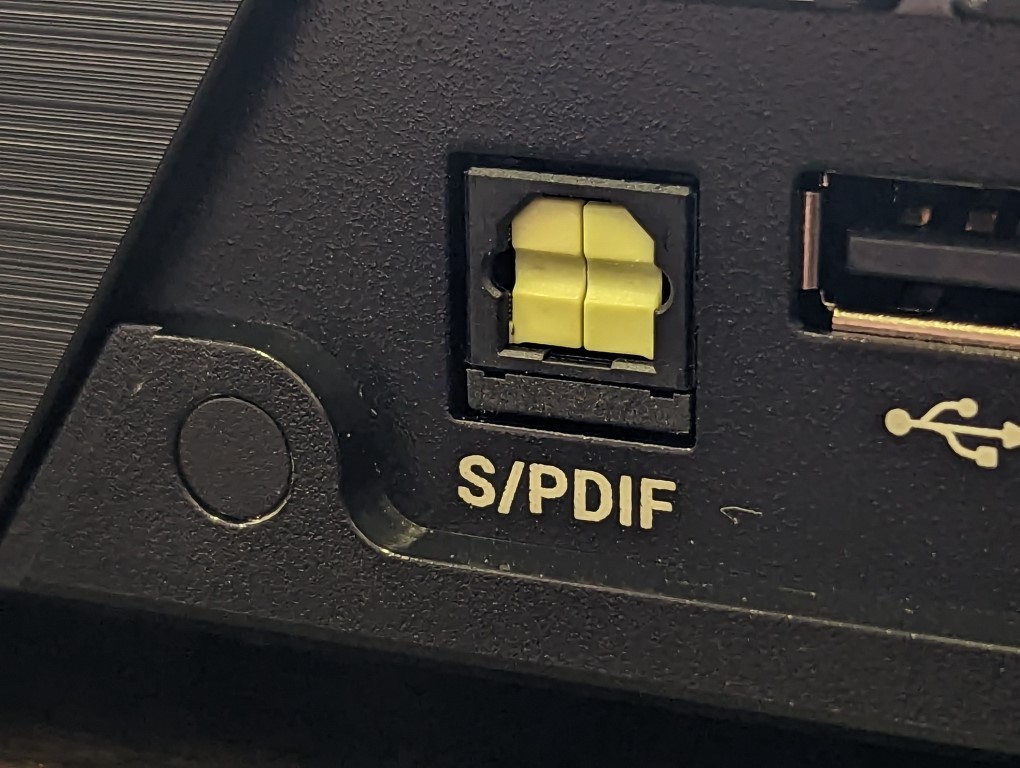
#2. Impressive Audio and Visual Connectivity
The general connectivity of this device, for its price point, is another area that left a positive impression on me when getting set for my review. Of course, there are USB ports for storage and accessories, two different network connection options, and then things get quite unique. Both of these devices arrive with not only HDMI 2.0B for increased visual bandwidth performance in 4K, but they also arrive with an SPDIF audio output. This is remarkably rare on network-attached storage devices and those looking to output high-end audio and dense audio format tracks directly into their expensive sound systems will appreciate the enhanced audio and visual connectivity on the Flashstor 6 and Flashstor 12 Pro.
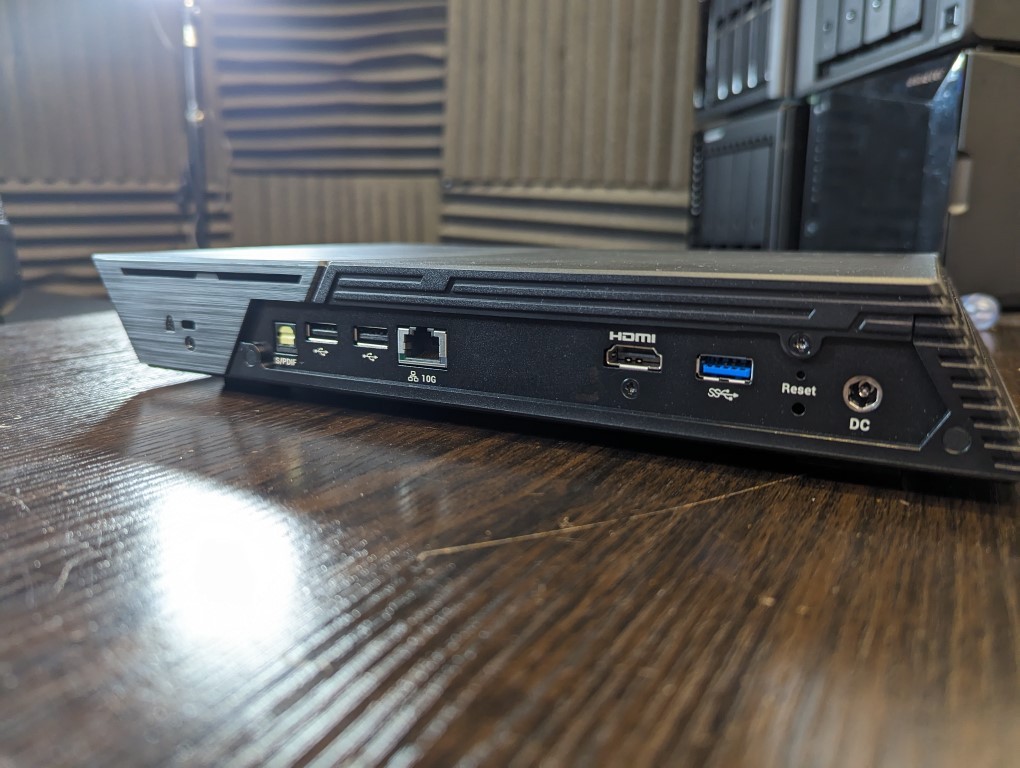
This is still arguably a niche for audio output, but there are certainly users who will be thrilled about this. The HDMI output is utilized with Asustor’s portal application, a complete parallel graphical user interface to access the NAS. It provides a full HDMI user interface that can be controlled via infrared remote control, network remote control, or just a simple USB keyboard and mouse. There are hundreds of available applications and services that can run via this HDMI output, allowing you to run a vast number of local multimedia and business services directly from the device. These range from first-party tools for surveillance and streaming 4K media, to third-party applications for connecting streaming subscription services and virtual machines.
#3. Between 6-12 M.2 NVMe SSD Bays in a Tiny Case!
I think the brand deserves credit for managing to fit such an extensive range of NVMe SSD storage media into this device. While they were not the first to develop M.2 SSD network-attached storage systems, they have managed to fit 6 Gen 3. NVMe SSD bays inside and still provide the rest of the hardware system services. This is even more impressive when, thanks to an additional internal component, the 12 Pro manages to house 12 NVMe SSDs. This system supports the usual RAID configurations, with each bay supporting a standard 2280 length M.2 SSD that can currently be purchased in up to eight TB, resulting in a system with a huge amount of storage potential in a compact physical form.
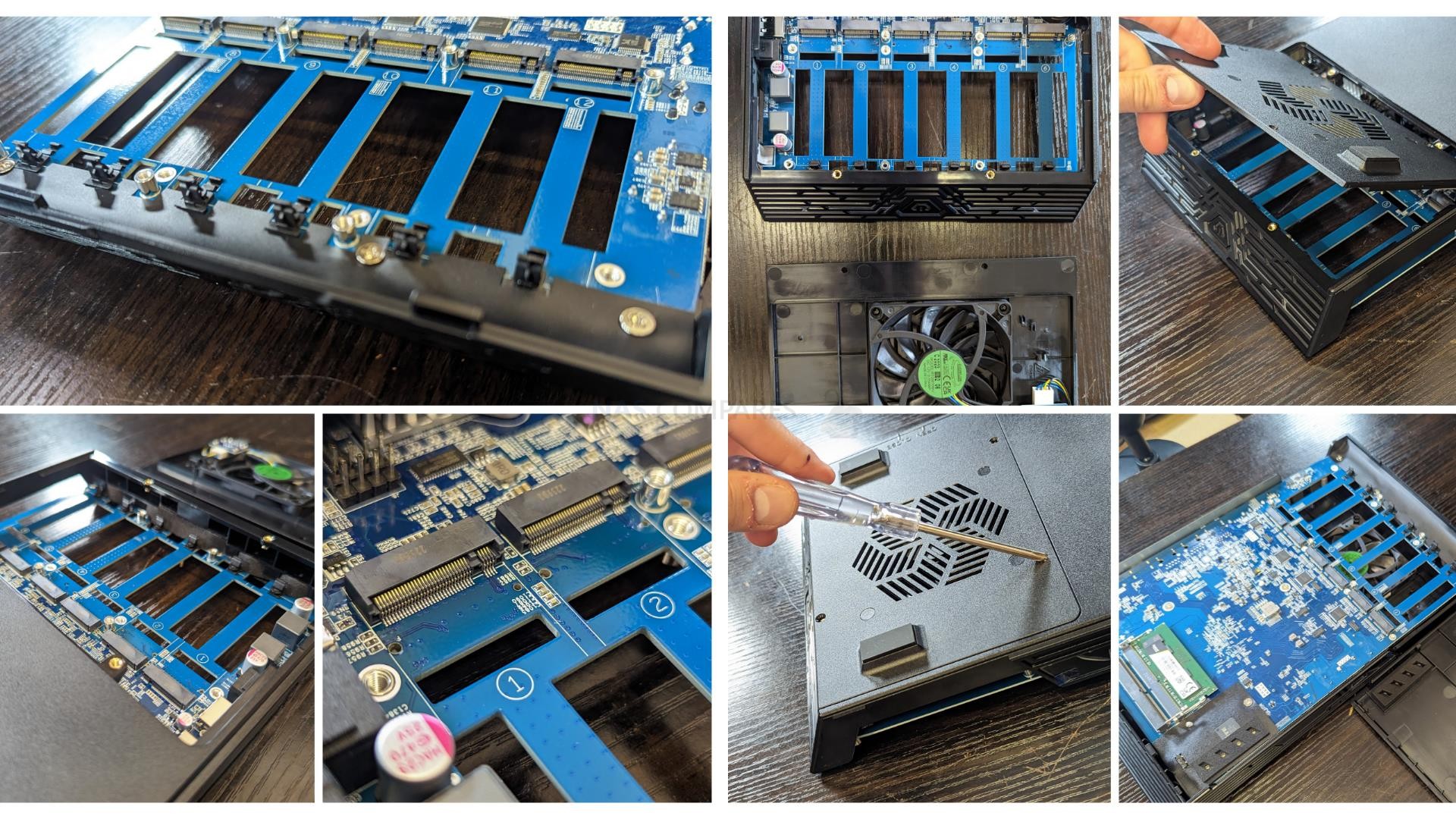
#4. Inclusive ADM Software in this NVMe SSD Turnkey NAS Solution
Alongside the hardware, when you purchase the Flashstor 6 or Flashstor 12 Pro, it’s also worth remembering that this includes a full NAS operating system, Asustor ADM. This software allows you to completely manage the system with its own dedicated graphical user interface that can be accessed via a web browser locally or remotely over the internet with the right setup. There are also numerous mobile client applications and even desktop applications to create better-tailored interaction and file transmission with the device, depending on the chosen file types. The GUI of this software is comparable to that of an Android, tablet, or even Windows desktop, with options to add further first and third-party applications via the app center. Alongside this, the GUI allows you to configure your main storage configurations, configure and access shared folders, manage a multitude of different applications and also allows you to create hundreds of users with their own bespoke access and tailored levels of secure access.
Finally, there are the little things such as support of BTRFS for the chosen file system, the wide compatibility of a number of third-party software and hardware services that can be integrated and managed by the software, and finally, there is a wide variety of first-party apps and services available. Asustor provides their very own surveillance platform that allows you to monitor numerous compatible IP cameras, several multimedia applications for photos, videos, and audio, and multi-layered backup and synchronization tools for managing data between you and your NAS, as well as NAS to NAS and NAS to Cloud backups. The software may not be quite as evolved and polished as the likes of Synology DSM, but it is certainly a good platform to get your teeth into and given the system already arrives at quite a fantastically well-placed price point for hardware, this software might well be a fantastic bonus too. Lastly, lest we forget as shown on our YouTube channel, if you wish to, you can install popular third-party software such as TrueNAS, unRAID, and Open Media Vault on this system if you wish. That does somewhat invalidate your warranty, but it does mean that you can install these fantastic open-source or low-cost NAS OSs to take advantage of the fantastic storage media inside the Flashstor 6 or Flashstor 12 Pro.
#5. Ridiculously Affordable Price Point for what it is, at $499
I cannot stress enough how impressed I am that the Flashstor 6 and Flashstor 12 Pro are priced at $499 and $860, respectively, given the level of hardware on offer here. These are by no means enterprise-grade NAS server solutions, nor should they be thought of as such. However, given the cost of typical fully featured 4x HDD solutions from their competitors and the brand themselves, which often start at $550 and above, it is quite remarkable that the six M.2 SSD system with comparable internal hardware comes in at $499. As long as a user keeps their expectations in line with what this cost versus its capabilities, it’s really tough to argue with the price point that these two devices have arrived at on the market.
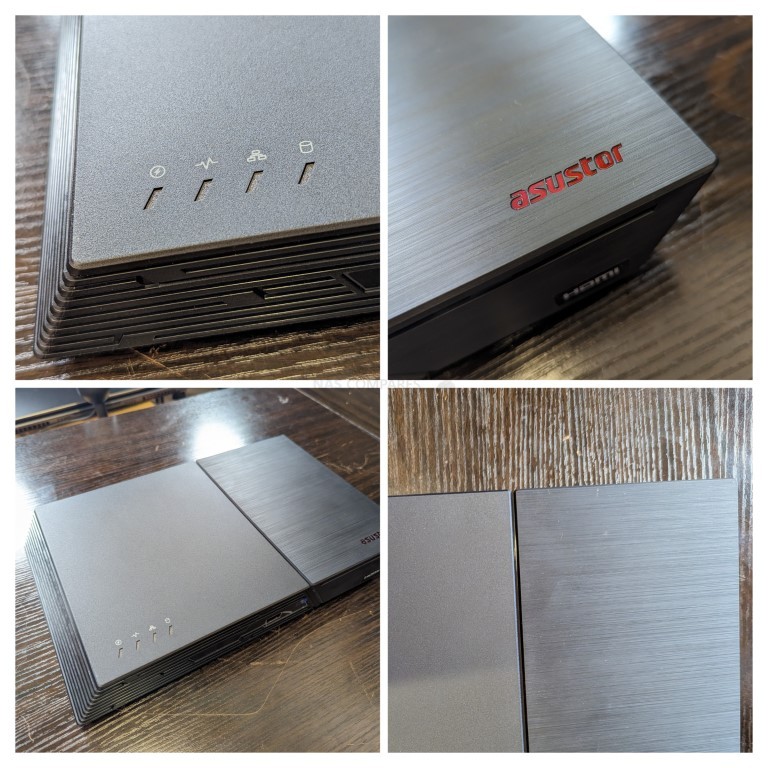
Asustor Flashstor 6 and Flashstor 12 Pro M.2 SSD NAS – Reasons You SHOULDN’T Buy?
Although the Asustor Flashstor series has alot of incredibly impressive features and abilities, it is worth keeping in mind that it is by no means perfect. Indeed, the thing that might make it less suitable for you and your setup stem from that same motivation by the brand to keep the device affordable. Here are five reasons the Asustor Flashstor 6 or Flashstor 12 Pro might be worth skipping in 2023/2024.
#1. Slightly Odd Choice of CPU
The CPU inside both the Flashstor 6 and Flashstor 12 Pro NAS systems is something of a contentious point. Now, we have to bear in mind that this system needs to maintain a certain price point, as it is chiefly designed to allow home and prosumer users to access a full M.2 flash NAS system affordably. Equally, the CPU inside this system, the Intel Celeron N5105, has already been featured on numerous other devices by both this brand and others. So the brand already has a decent amount of experience as to what they can achieve with it on a hardware or software level. However, this CPU also means that the range of PCI slots that the hardware configuration has access to for its supported ports, connections, and storage interfaces has a glass ceiling. Now, I appreciate that they want to remain within a certain price point, however, there are other processors on the market in the form of Pentiums or AMDs that would open the door to more lanes being used. This would mean higher performing storage and better potential for connectivity. Again, that may have raised the price a fraction at retail to accommodate a more expensive CPU, but as this device’s price point is already noticeably below most of its competitors, I think perhaps the brand could have decided to up the choice of processor a few notches and increase the price by $100 or so.

#2. M.2 NVMe SSD Slots are PCIe Gen 3 x1
One of the earliest consequences of this choice of CPU, as mentioned above, is that each of the PCIe Gen. 3 slots that are occupied by an M.2 NVMe, are capped at Gen. 3 x 1. This is a shame because the majority of Gen 3 M.2 SSDs on the market are PCIe Gen 3 x 4. This ultimately results in each of these bays having an approximate 1000 megabytes per second bottleneck compared with a regular Gen 3 x 4 deployment, which would allow bandwidth of up to 4000 megabytes per second. Once again, this is the result of that CPU choice having fewer lanes to play with, but also this in turn means that the potential internal performance of these SSDs will likely cap at around 3000 to 4000 megabytes per second. Even with all the SSDs in an appropriate RAID.
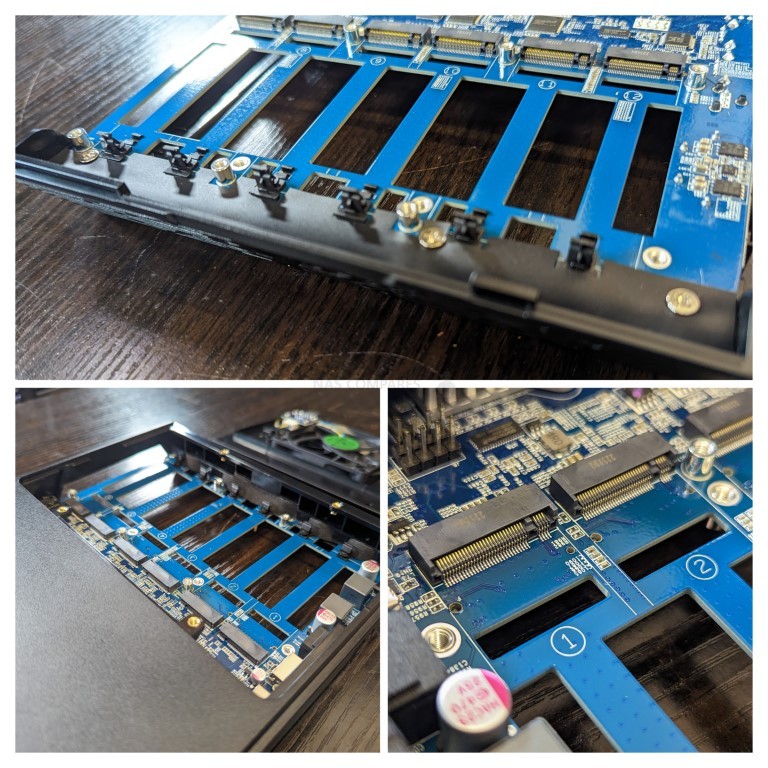
This is still a phenomenal amount of internal performance and for those running complex virtual machines or databases from the system, these benefits are still going to massively outweigh the performance of traditional hard drives. Nevertheless, there are going to be some users who may not realize that SSDs installed inside either the Flashstor 12 Pro or Flashstor 6 are going to have this bottleneck in place. So do not assume that installing 6x WD Black SSDs rated at 3000MB/s each in a RAID is going to result in tens of thousands of megabytes per second performance.
#3. Network Connectivity is a mixed bag
Another victim of the choice of this CPU and trying to remain within an affordable price point is that the network connectivity of both the Flashstor 6 and Flashstor 12 Pro is something of a mixed bag. In the case of the six-bay device, the system arrives with two 2.5 gigabit Ethernet ports. These can be aggregated in a number of different ways to achieve 5Gbps, and there is even support for USB to network adapters that can be used to increase this further still. However, that is still a tremendous difference in external throughput compared to what the SSDs are capable of inside the system, even with this modest CPU.
In the case of the 12-bay device, the system arrives with a single 10Gbps copper connection and support for USB network adapters too. This still leads to something of a bottleneck when you consider what 12 M.2 NVMe SSDs, even capped at Gen 3 x 1, are able to achieve. Again, I appreciate that the CPU choice here and its impact on the rest of the components has been made to keep the system at an affordable price point and to allow lower-tier users to access flash storage when the bulk of flash systems on the market right now are squarely aimed at enterprise users. But users need to be aware that the throughput of the storage media inside this device is subject to a little bit of compromise in order to remain affordable.
#4. Lack of Inclusive Heatsinks
This is a minor complaint but still worthy of discussion, in my opinion. Both the six-bay and 12-bay systems do not include SSD heat sinks. Now, there is the argument that many SSD brands provide their drives with heat sinks by default. Equally, there is the fact that the SSD slots inside the Flashstor 12 Pro and Flashstor 6 are capped at Gen 3 x 1, and therefore will not get as hot as if they were used in a system running with traditional 3×4 bandwidth. However, given the close proximity of all this storage media and the fact that the system utilizes a predominantly plastic chassis with no top or bottom metal heat-dissipating panels (though the CPU and several key components do have their own heat sinks), I would definitely feel more comfortable if this large arrangement of storage that has been packed together included heat sinks. It seems unusual that the brand has not included them.
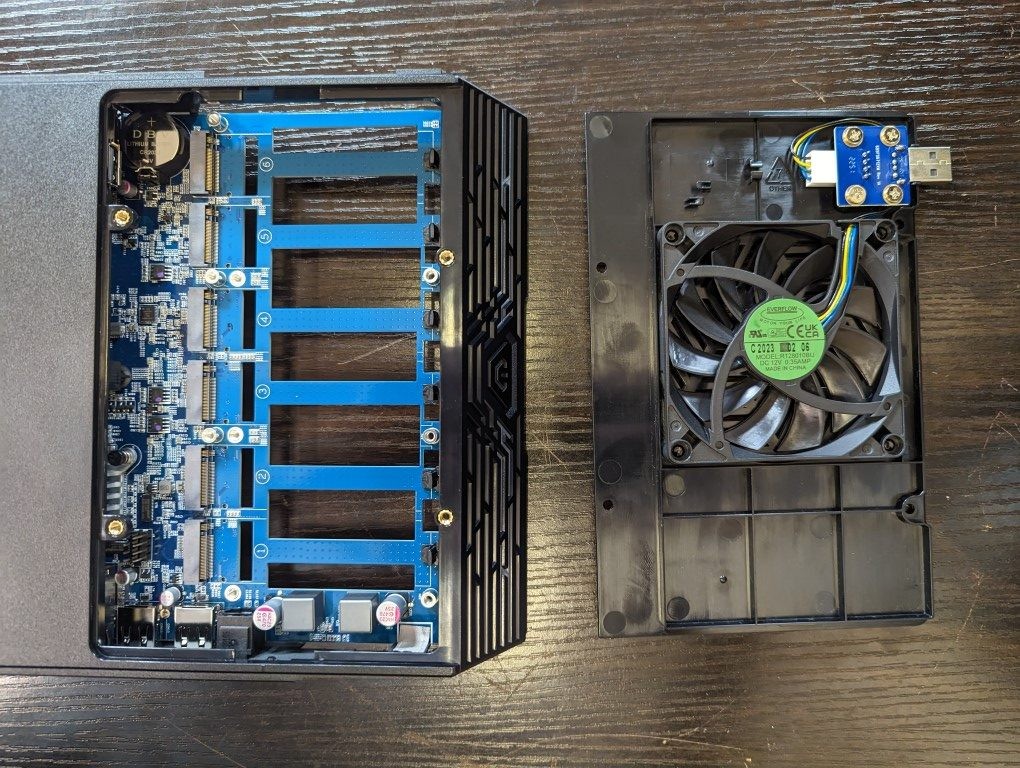
There is an active cooling fan located directly beneath the storage base of both the Flashstor 6 and Flashstor 12 Pro, but even then, the heat generated by the controllers of SSDs typically works at their best when they are transferring their gathered heat towards a heat sink that allows it to be dissipated into the air. I have used several compact NAS systems in the past that use exclusively M.2 SSDs, and the bulk of the affordable ones arrive with 3×1 or 3×2 architecture for those storage bays. They have all included heat sinks for their storage media, and despite numerous observations by the brand when I raised this, stating the drives were not able to be accessed heavily enough to justify inclusive heat sinks and increasing the system price, it still seems an odd omission for the retail kit.
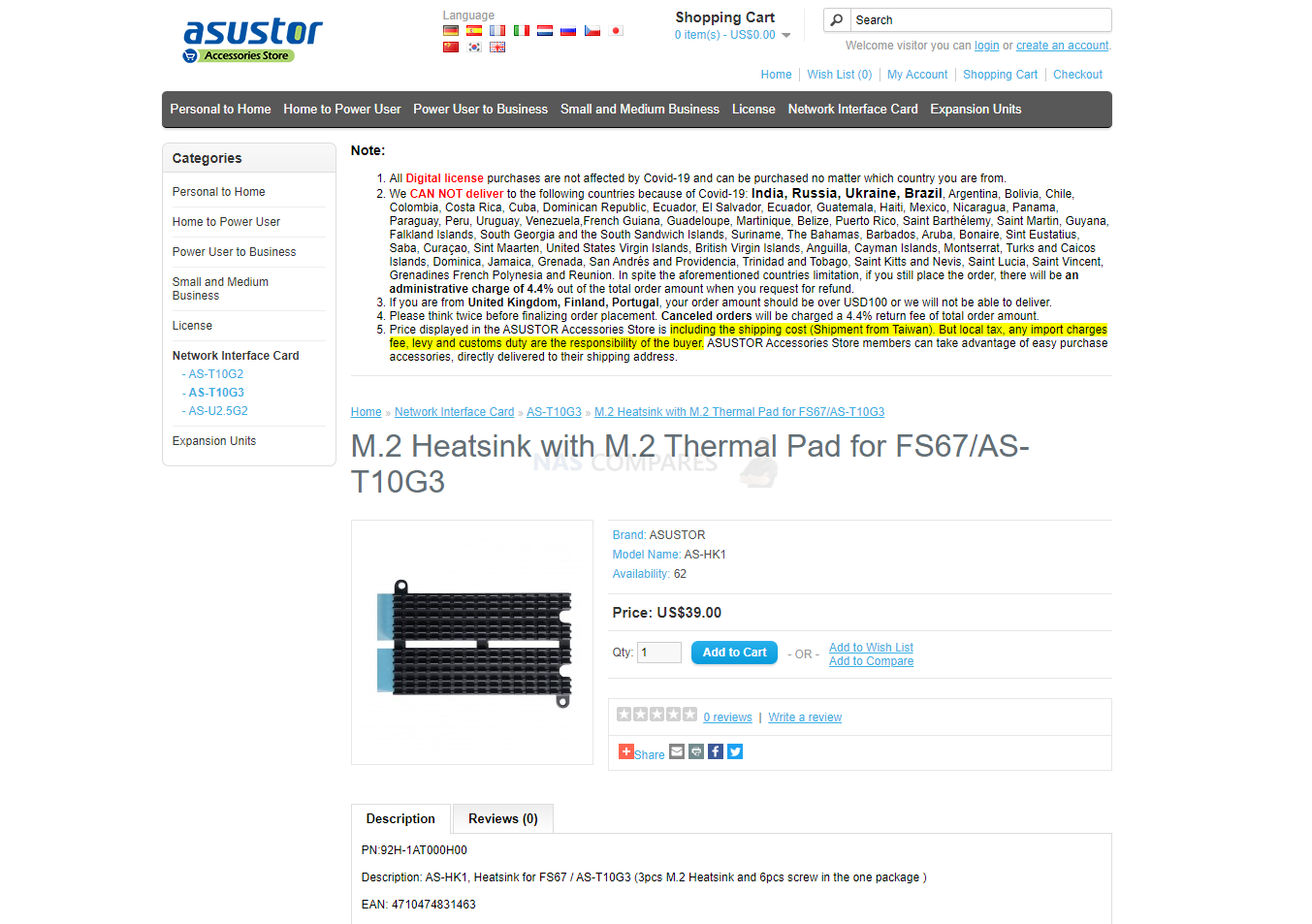
This is hardly a deal-breaker as M.2 heat sinks can be picked up at retail for as little as $5, and no doubt at production would cost a fraction of that. However, that just increases my disappointment that they were not included in the first place.
#5. The Deadbolt Ransomware Attack in 2022
Though not directly connected to either the Flashstor 6 or Flashstor 12 Pro device, it is worth highlighting that this brand was one of several targeted in 2022 by the ransomware group, DeadBolt. This ransomware attack resulted in numerous users finding their systems encrypted via a remote access attack that resulted in them either having to accept the loss of all their data or pay a ransom to the attackers in order to retrieve their data. Now, we could spend days, weeks, and months discussing who is liable for a user’s backups, managing regular system updates effectively, and who is responsible when a system is rendered insecure at the point of the ports!
However, there is no avoiding that Asustor definitely needs to take their share of the blame. Since the ransomware attack, they have significantly changed a number of system defaults in their inclusive software, altered a lot of the system setup choices, and numerous network protocols within the software have been changed to ensure that they cannot be rendered insecure to the same extent by the end user without significant manual override. Nevertheless, there will always be users who will be suspicious of products from this brand, at least for the next few years until they are able to shed the stigma of being successfully targeted by ransomware. It’s worth highlighting that they did manage the ransomware attack significantly better than rival QNAP. But then again, the scale of both of these companies and the sheer number of products they have deployed is also widely different too.
📧 SUBSCRIBE TO OUR NEWSLETTER 🔔 This description contains links to Amazon. These links will take you to some of the products mentioned in today's content. As an Amazon Associate, I earn from qualifying purchases. Visit the NASCompares Deal Finder to find the best place to buy this device in your region, based on Service, Support and Reputation - Just Search for your NAS Drive in the Box Below
🔒 Join Inner Circle
Get an alert every time something gets added to this specific article!
Need Advice on Data Storage from an Expert?
Finally, for free advice about your setup, just leave a message in the comments below here at NASCompares.com and we will get back to you.
 Need Help?
Where possible (and where appropriate) please provide as much information about your requirements, as then I can arrange the best answer and solution to your needs. Do not worry about your e-mail address being required, it will NOT be used in a mailing list and will NOT be used in any way other than to respond to your enquiry.
Need Help?
Where possible (and where appropriate) please provide as much information about your requirements, as then I can arrange the best answer and solution to your needs. Do not worry about your e-mail address being required, it will NOT be used in a mailing list and will NOT be used in any way other than to respond to your enquiry.
TRY CHAT
Terms and Conditions


Best NAS for under $499
Best NAS for Under $250 (2025)
Minisforum N5 Pro NAS - FIRST IMPRESSIONS
HexOS Q2 Update - What's Changed?
5 Exciting NAS Coming Later in 2025
Beelink ME Mini vs GMKtec G9 vs CWWK P6 NAS Comparison
Access content via Patreon or KO-FI


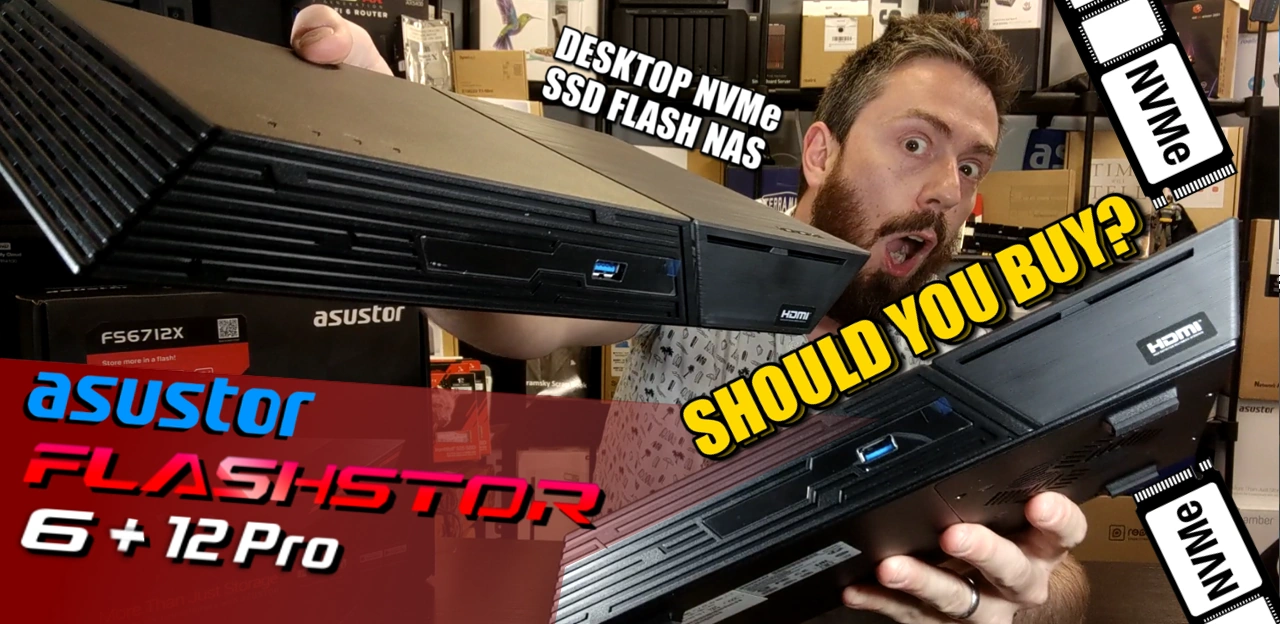
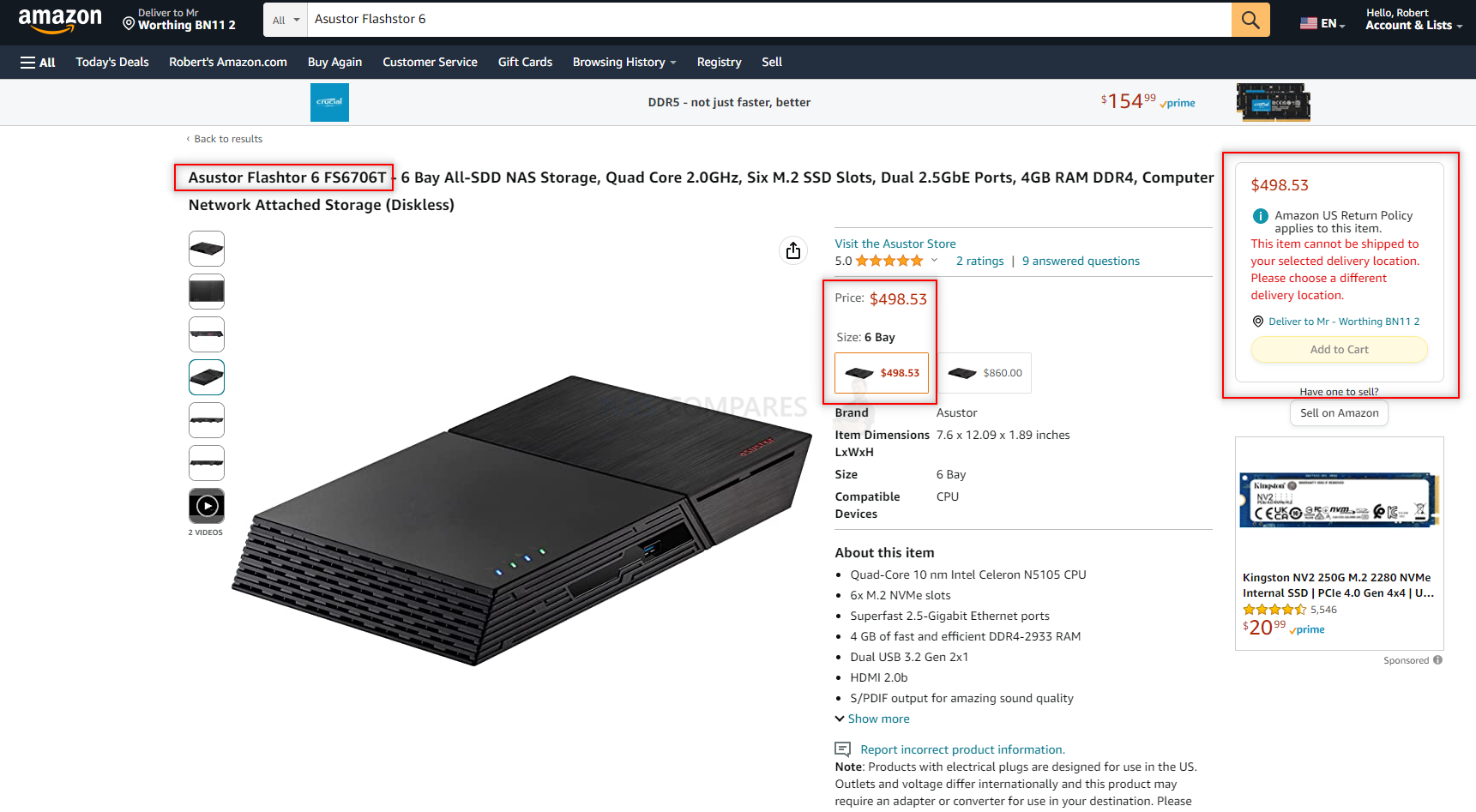

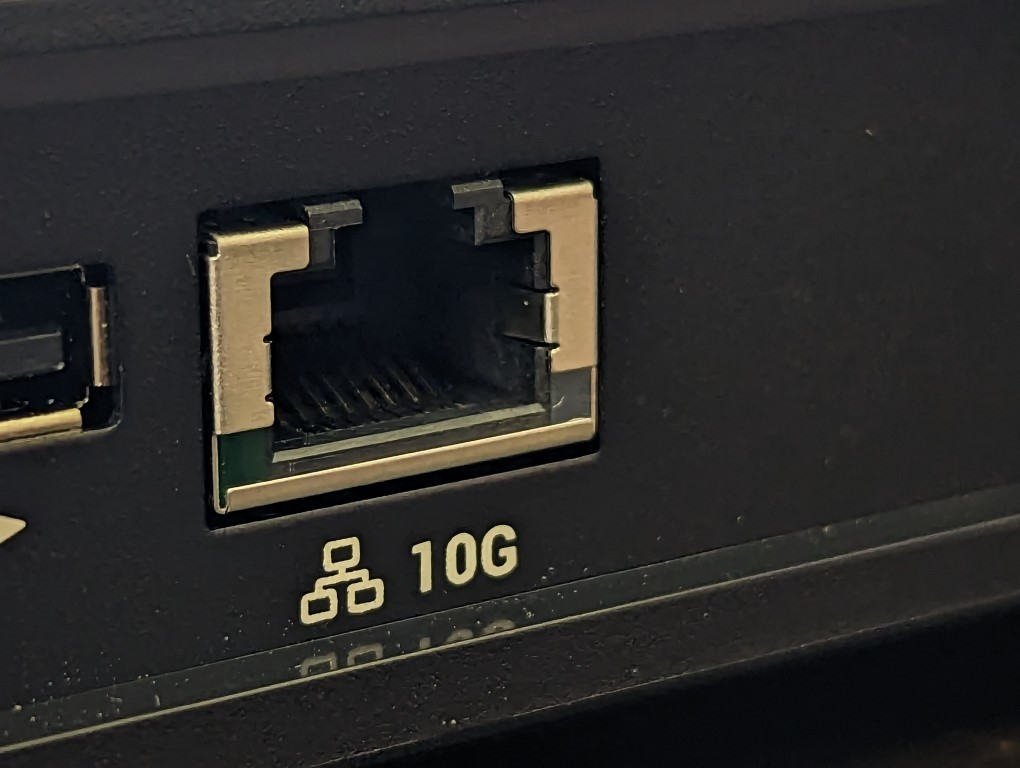
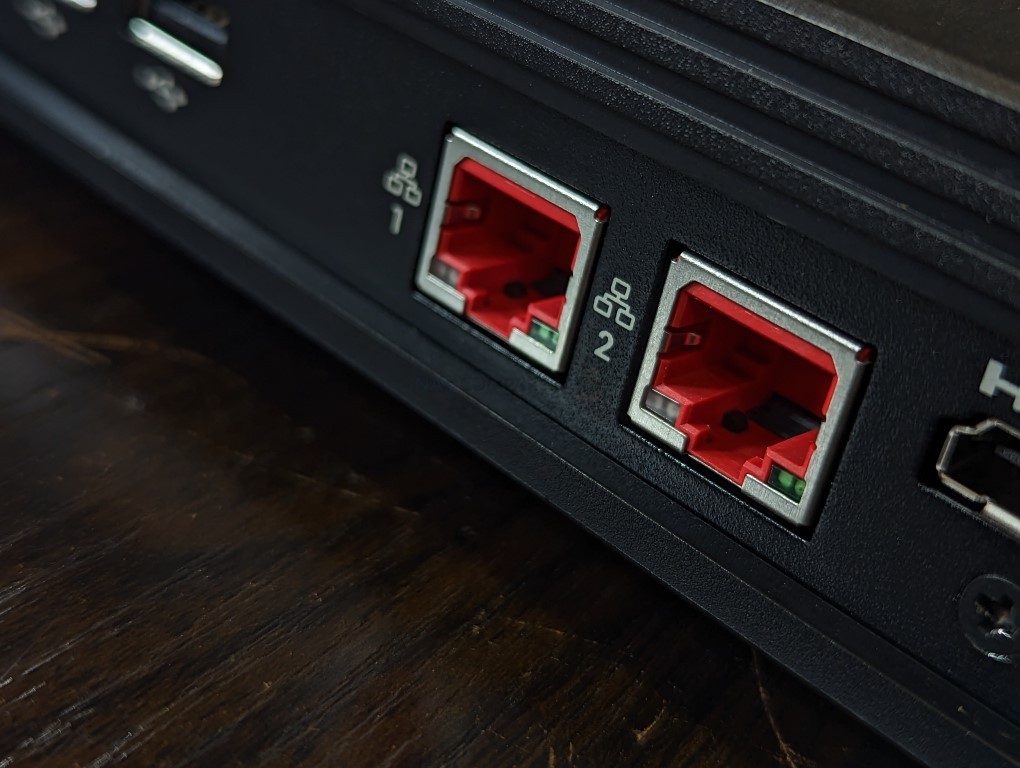



Hello there, I need help. I’m in the process of buying my first NAS for home. My requirements are very simple. I will be using it mainly for storing & viewing family photos & videos (fond memories), movies & music (personal collections) and personal documents. I’m in a dilemma, unable to decide between ASUStor Nimbustor Gen 2 AS5404t (4 bay NAS) and ASUStor Flashtor Gen 1 FS6706t (6 bay all SSD NAS). Kindly help me in deciding – both cost the same in my country right now… Thanks in anticipation.
REPLY ON YOUTUBE
When I hear you referring to these units as “cheap” or “affordable”, I have to wonder if it’s me who’s living on another planet, or you. I think they are horrendously priced. Perhaps you are thinking of their use by large companies? But just saying they’re less horrendous than some of their competitors doesn’t make; them affordable for a lot of us.
REPLY ON YOUTUBE
Do you have a video on how to set up fs6706t for a novice?
REPLY ON YOUTUBE
Probably a great review video, but I have to say that I don’t understand point #1. I could puke looking at this device, and I wouldn’t even want to put it into a closed cabinet. It’s a great device in terms of functionality and price, I’d definitely want to see more of these on the market, but the design really rubs me the wrong way.
REPLY ON YOUTUBE
Do you have any cpu heat issues? I’ve read on Reddit that some said there is design flaw that the contact of the cpu heatsink isn’t contacted correctly to the CPU
REPLY ON YOUTUBE
The M.2 is still moving data at much faster than the Ethernet speed.
REPLY ON YOUTUBE
Most gen4 SSDs are available with heatsinks, so that issue is solved. Quite an appealing device, this, and the HCL lists a lot of consumer SSDs.
REPLY ON YOUTUBE
I am debating between DIY vs Terramaster F4-423 (currently at $399) vs this unit (Flashtor 6). I’ll be using it for basic storage and remote cloud access (Gdrive GPhotos replacement potentially Home Plex Server). What do you recommend?
REPLY ON YOUTUBE
Seriously considering one of these. M.2 is cheaper than SATA for flash storage.
Any other storage appliance offering a good option for flash storage is incredibly expensive.
REPLY ON YOUTUBE
Too much talking, not enough substance just couldn’t spend any more time on this
REPLY ON YOUTUBE
I think the worst Problem is realy the CPU. If Asus has used something like an AMD V1500B or an R2314 with 15 Watts but 16 PCIE 3.0 lanes, they could use 4 lanes for the NIC’s and USB which would be enough to even saturate a dual 10gbit NIC and 2 10gbit USB 3.2 Ports at the same time. That the NVME only run at 1GB/s or 2GB/s at the Store 6 wouldn’t be the problem. But with intel there are no efficient 16 lanes processors, so you have to go AMD which is notorious problematic at providing embedded Prozessors, Synology has some around.
REPLY ON YOUTUBE
After watching your reviews we have bought the Flashstor 12 for our video editing NAS. Great so far. One of our editing laptops is older and only can support 2.5Gb ethernet adapter speeds due to USB 3.1 Gen 1 bottleneck. If I got a second 2.5Gb adapter is it possible to set it up to get 2x 2.5Gb throughput❓ If so what do I need and how do I set it up❓
REPLY ON YOUTUBE
Thank you for the review of this product.
I have been giving consideration to it and the form factor along with the SSD’s does have an appeal. This would be a home use application that does have SD, HD and 4k movies. There is also a fairly large amount of music files as MP3 and video as well. Other than that, it’s all about data and the combined volume is in and around 7TB. Again; home use two users.
The question: what Drives of good quality would you recommend? I also understand through reading, the device is RAID capable. Is that part correct?
In advance, thank you!
REPLY ON YOUTUBE
The product shows registered, but the website says it’s not, so I can’t open a ticket. I leave voice messages with Asustor and they don’t return my calls. I’m kind of stuck and not happy with their support. The 12 bay unit is displaying errors when I scrub and sometimes says the resource is not available. I don’t have these kinds of issues with NAS units from other brands. I’ve never had to contact the manufacturer for the other NAS units I have. Disappointing.
REPLY ON YOUTUBE
Disappointing. Talking very long about the procuct but still nothing about the noise of the device. If you are just saying “they are not loud” – that is not enough, I have heard the exact same comment about NAS as loud as a hairdryer.
REPLY ON YOUTUBE
In your next video, can you please advise the best NVMEs to use based on the throttling of Gen 3 x 1 and how to populate the NAS for best throughput i.e. is 3 NVMEs with Raid 5 the best. Thanks.
REPLY ON YOUTUBE
Next time, please do deep review for Adm Firewall. I guess many people like this!
REPLY ON YOUTUBE
N5105 – Max # of PCI Express Lanes = 8 – Each NVME = Capable of 4 lanes. Whats the point of running NVME? May as well use SATA SSD’s.
Now does anyone (at home) have the capability to run 60Gb/s (12x5Gb/s) networking. Nope. But….. Thinking outside the box and allowing for smb multi channel. maybe a third edition 12 bay, a ‘proper’ processor, with 4 10Gb/s SFP+ on the back and we might have some serious sales. There are definitely people out there who have that sort of capability. (like me)
10Gb networking for home is a sensible price currently with mikrotik but 25/40/100 is still going to be real pricey until corporate entities start rolling this stuff to the pre-loved market
REPLY ON YOUTUBE
Hi, you were to spend around $600 for a NAS, which would you buy?
REPLY ON YOUTUBE
Look like this storage running with Android OS, because i found that the apps are using apk
REPLY ON YOUTUBE
Jeez, I’m glad I found this channel. So much good info.
REPLY ON YOUTUBE
For anyone interested, I have six Crucial P3 Plus 4TB CT4000P3PSSD8 PCIe 3.0 and they work just fine in my Flashstor 12.
REPLY ON YOUTUBE
I’m having trouble connecting it to SABRENT 10 bay hard drive docking
REPLY ON YOUTUBE
Definitely interested but it is quite ‘plasticky’. I would have been keener to buy with a metal chasis, plastic just doesn’t say quality. I am quite keen to see what the competition produces that is similar. Kudos though for kicking off this type of NAS.
REPLY ON YOUTUBE
Hmm. Need something like this but with ZFS and encryption capabilities. I guess that would need a stronger CPU. I don’t really care about the external bottleneck, even 1 Gb is more than enough for what I need. I do care about the dimensions, noise, and power consumption, which far outweigh the network limits.
Can you boot a TrueNAS on this or is the system drive vendor-locked?
REPLY ON YOUTUBE
I have WD My cloud and no month fee,what are with Asustor?I hear,that for any need to pay any month fee.
REPLY ON YOUTUBE
I’ve recently found your site and your reviews here. Great job!
I’d like to know if this would support having a SSD pool to have a PS 5 access it for game storage. Not sure how a PS5 would deal with NAS storage for game content.Any thoughts?
REPLY ON YOUTUBE
14:04 — “a thousand megs per slot” . . . but assuming that is (or is not) with all six slot filled?
For instance, if I make a pool out of three of six slots on FS6706T, then will each slot in such a pool get double that (i.e., 2,000 megs per slot)?
With much appreciation. Great video ????
Kindest regards, friends and neighbours.
REPLY ON YOUTUBE
Is there any drawback to connecting the NAS to a Mac Studio with SSD for the 10G speed and the rest of the computers on the network via ethernet? Do you get the same functionality in terms of storage and apps?
REPLY ON YOUTUBE
Is not need ECC RAM for a reliable NAS?
REPLY ON YOUTUBE
Any solution for the “Uninitialized” situation? I’ve updated the firmware on my NAS, so it’s not encrypting files anymore, but I still have the “Uninitialized” status. If I initialize the drive, it will erase all data. It’s amazing how little information ASUSTOR has on this attack.
REPLY ON YOUTUBE
I saw your review of the Asustor Flashstor 12 Pro NVMe NAS and liked it, but I think there is missing information, such as:
The type of memory used, is it ECC?
Do we need to buy heat sinks for the M.2 drives?
What is the type of the PCI lane connection, is it 3.1 or higher?
Best budget that i found in Portugal was:
Nome Marca unidade Preço Totais Preço Final
ASUSTOR 12-Bay M.2 FLASHSTOR 12 PRO Asus 1 898,90 € 898,90 €
Samsung 2TB SSD 970 EVO PLUS M2 PCIe – MZ-V7S2T0BW Samsung 12 113,58 € 1 362,96 € 2 333,90 €
Samsung 2TB 980 Pro NVMe – MZ-V8P2T0BW Samsung 12 143,82 € 1 725,84 € 2 696,78 €
Memória RAM Kingston 16GB 2666MHz DDR4 Non-ECC CL19 SODIMM – KVR26S19S8/16 Kingston 2 36,02 € 72,04 €
Just for reference. Thank you for your attention. Keep up the good work.
Best regards.
REPLY ON YOUTUBE
Due to the throttling of the SSD’s, what 4TB sticks would you recommend?
REPLY ON YOUTUBE
Please, please stop using the astonished “Mr. Beast” look thumbnail for the upload.. It is an instant turnoff.. ????
REPLY ON YOUTUBE
I really miss the youtube app in NAS (AS6704T) to watch it on my TV. Asusstore please add it app central.
REPLY ON YOUTUBE
Spdif is a no for me. I am getting one of these but will be going Ethernet to my transport to the DAC. This will be replacing my DS220+. Fits and better looking ????
REPLY ON YOUTUBE
Let’s all face facts – if you’re expecting to fill a 10Gbps link with traffic all the time, or want/need a 25Gbps or 40Gbps+ link, you’re not looking at Asustor. You’re looking at professional solutions. My potential use for this is in long-term NAS storage, not performant storage. Meaning, I want to have 12x4TB disks in RAID 6, and load them with Plex data, and let them sit there. For over a decade. And be reliable. Something spinners can’t really nod their head at. With RAID 6 NVME drives, I would expect easily 10+ years of use – I’d expect that the CPU or memory may suffer a defect long before the drives die. The only thing I wish the 12 bay unit had would be dual 10Gbps ports – not for throughput (and I’m sure some people would scream about that) but for redundancy, so that if I do a switch upgrade and it reloads, nothing is interrupted from a file mount perspective.
REPLY ON YOUTUBE
Good NAS Good job ASUSTOR
REPLY ON YOUTUBE
*Note* – Fairplay to @ASUSTORTV , after my criticism of the system not arriving with M.2 SSD Heatsinks, they have produced a test video showing compelling evidence that the PCIe Gen 3×1 slots are not able to generate enough heat on a x1 speed each. I will be conducting sustained tests later on that factor in spiked use, but I have to hand it to them, it is a great response and makes a solid case. You can find their video here – https://www.youtube.com/watch?v=Vr__5B3oGtM
REPLY ON YOUTUBE
Some notes about these Asustor FS 67 series NVMe NAS’s….
1. Currently the only 4TB NVMe supported is the WD RED 4TB (WDS400T1R0C-68BDK0) per the Asustor HCL .
2. The NAS will stream DSD (up to quad-DSD) to an attached USB DAC. However, none of the USB DACs listed on Asustor’s HCL support DSD.
REPLY ON YOUTUBE
cand the SSD be mix and match or all the same?
REPLY ON YOUTUBE
So if I understood this right, If I’m still running a 1Gbps switch/router my home network would be the bottleneck not the NAS itself right (with the 6 bay)
REPLY ON YOUTUBE
The 1GBps per drive comment isn’t exactly accurate. Due to the CPU only having 8 PCIe lanes, they’re using ASMedia PCIe MUX chips to share all of the PCIe bandwidth. In a RAID6 array with all 12 bays populated with 2TB Intel 670Ps, I haven’t seen more than around 3100 MB/s reads and 840 MB/s writes.
REPLY ON YOUTUBE
Wait… Let’s nip this in the bud, shall we. Making no apology, this is a ha’p’orth o’ tar situation, though in NAS terms we are talking more leaky coracle than creaky man-o’-war. More than that, here is an offstage exercise in elephant wallpapering. Having said that, I do agree pretty much with mostly all you’ve said in your pros and cons presentation, and with ASUSTOR TV clarifications and rejoinders – but!
It’s one thing to announce that the Flashstor is populated exclusively with NVMe cards, whilst waving the like to your ear. I can’t fault your delivery. It’s priceless. NVMe cards are silent as a dead parrot, of course. But the so called bad boy Flashstor NAS – with a manufacturer stated Operation Noise Level of 18.7 dB due to the built-in active cooling fan – is, well, audible. Not just audible, but with a strangely metallic, nay, ironic quality to the noise it produces.
Very quiet, and barely noticeable, are relative euphemisms, like almost silent, not useful in translation. Every ear hears what it will. An acceptable level of noise depends subjectively on individual use case scenarios. I suspect the majority of any gathered assembly will be quite comfortable agreeing to differ on the intrusiveness, or otherwise, of a quiet device.
Should you buy it? On a promise it never makes and doesn’t need to keep? See below. Even if you convince yourself to overlook the inclusion of a fan in the specification you won’t be spared the morning after. Remove the fan, or if it stops working of its own accord, and there is a series of loud beeps to alert all those within earshot. No secret. It insists functionally on being present and correct, and, as I may have indicated, it is noisy. It oughtn’t be, but it is. Thanks to two significant factors: a) aerodynamics, that is diameter/rotational speed/blade design, and in particular b) dual ball bearings.
I suggest a line be drawn at the apparently casual use of the word silent since it means something entirely different, by varying degree indicative of subjective experience of noise level, to the word quiet. (Aside – You might want to call the latter virtual silence. Mmmm, a bit 70’s. How about artificial silence. Ah, yes, now that’s modern. Of course, it still means categorically not silent in any way whatsoever, rather of questionable value, a compensatory poor substitute for the real thing. Who cares.)
If you require silence, as in Solid State Drive, and wish to eliminate noise, as in Hard Disk Drive, then buying this machine is a straight forward mistake. Silent running is statedly not a design goal of Asustor for the Flashstor. That being the case, what exactly is the unique selling point of it? The case is sturdy, but looks ridiculous and those are fake exhausts on the front, whatever Robbie told you. If the proprietor also spreads the idea that its firmware potentially is written to deny service to those seeking to install other operating systems or scupper rival investment group’s memory modules then at best it is an impressive marketing exercise. Impressive as in pressurised sales loosening your grip on reality and in turn making a big dent in your paltry bitcoin collection. So keep your eye on the pea. Let’s go.
Highly desirable, a silent domestic NAS device is a simple and clear objective concept. A design goal. Not a missed target. Not an Asustor. Not even a Flashstor. Not yet, anyway. To this day, the only silent NAS is a NONAS.
“We really wanted to make this quiet. Otherwise it defeats one of the purposes of an SSD NAS.” ASUSTOR TV on Flashstor thermal design.
There it is again. That word. Quiet. Which means a degree of noisy as opposed to silent, which still means no noise.
My DS415+, admittedly with Noctua fans, is quiet. The reason for upgrading the fans is to eliminate the metallic grinding sound of ball bearings, to make the fans mostly tolerable. But it isn’t silent with four WD Red 3TB HDD. The escaping chronic fixed level mechanical grinding sound, more than the lively seek chatter, is a depressive ergonomic that is unnatural to the ear and a factor in long term hearing loss. That’s why most sysops tend to not live in the server room, or for that matter the plant room, or indeed the belfry. What? Away then, with those naughty hard disks and their moving parts.
“We really wanted to make this quiet.” Really. If by quiet you mean to some extent noisy, you succeeded. You didn’t. You did otherwise. Strange, but true. In doing so, as vouchsafed, you defeated one of the purposes of an SSD NAS. The distinguishing purpose presumably being to follow through silent (not quiet) solid state disks with a silent (not quiet) solid state chassis. You know. Silent storage. Instead of quiet (to some extent noisy) storage.
By design. Quiet and not silent. Why is that? It needn’t be that way. Why stop at swapping out the last of those noisy spinning hard disks to do only half a job by leaving in a noisy spinning fan?
With respect to the Flashstor, use of the word silent is merely adjectival funny business, or perhaps fanny business. What I mean is this. A useful practical description of an object ought to align itself with the uniformly objective convergence of common experience and yield to independent measurement and verification. Thus, silent is probably a non-starter as there is a ball bearing attached. Unless that fan is off, that is, or running on mag-lev oil bearings below the bar of a gentle draught, which it isn’t in this case.
Thursday there were two Flashstor 6 in stock on Amazon UK – then there was one. Closer inspection of the design would suggest that Asustor decided wilfully not to render the wannabe silent NAS in fact, silent. The thick plottens. The design includes certain case screw heads, including the fan screws, buried under pressed and recessed hard plastic caps that defy attempts to disassemble. The dimensions of the custom fan itself are suboptimal to sourcing better performing parts. Fan replacement is therefore a factory repair. Good luck with that. One is physically hampered even from modding the Flashstor for peace and quiet. One may be seen but not heard, but one’s NAS – not so much.
When the Flashtor NAS is up and running, it’s tiddly built-in fan is up and running. The ball bearing noise can be heard distinctly and penetratingly across the room. This is not to mention the rushing sound of air. Asustor has almost succeeded with that, although the fan is rather small. In fact the airflow can only be heard if one waves the entire NAS to one’s ear or, equally, places one’s ear really quite close to it.
That is not the major problem. The fan shifts enough air at idle to keep the inner workings from overheating and the airflow often is inaudible depending on the ambient sound of working conditions. Only in the dead of night, when you should be asleep anyway, or if you are fortunate enough to work in library conditions, can this humble rush of air be heard. The poor wee fan has to work the surrounding air a little too vigorously to waft the necessary draught. The sound level is very much like a DS423+ on SSDs, sporting replacement Noctua fans fitted with series resistors. Don’t ask me how I know. Don’t get me started on those cheap rattly Synology fans in a flimsy case. Why do you think I took in the Flashtor? Desperation. It certainly wasn’t for looks.
I want to live with my NAS, not to have to listen to it when I require to hear a pin drop. A little more commitment to acoustic performance could easily have resulted in a silent Flashstor. Misanthropic marketing motivated by the boundless wonder of public imagination supposes why produce something good and well-engineered straight off the bat when you can sell it again, and again, and again. To the tune of a waltz.
The problem is this. And this is the whole point. Asustor have used, not the cheapest fan design it demonstrates reasonably good aerodynamics and manufacturing but cheap enough to suffer from noisy ball bearings. I say suffer, because the sound is remarkably similar to the grinding sound of a spinning hard disk.
So here’s a paradox for you. The elephant in the room is the Flashtor itself. As a design and marketing concept it is admirable: bold, striking and courageous. However, you could say that its greatest asset is at the same time its inevitable downfall. It is a victim of its own success. It contains the seeds of its own destruction. In other words, it has balls. And it’s a little fanny.
There is only one thing more disheartening than suffering from noisy ball syndrome, and that is foisting your head splitting ailment on sensitive, imaginative types who are trying to manifest (let’s be generous) original thinking. That, and the blinding irony of an SSD NAS sounding for all the world like a wheezy old dog of an HDD chassis. Oooh, the bells! The decibels!
12th Gen Intel NUC with a Core i5-1240P 35W TPD in the Akasa Turing passive case with a 2.5″ SSD, mSata and NVMe is for real. Silent. Oh, the sheer relief. Obviously, that represents overkill for power in a domestic NAS. Count them. How many cores? But proof of concept beyond doubt by an order of magnitude. The removal of barriers to achieving a silent NAS. How are you going to test the market for silent NAS if you don’t release one? I see, you are testing the market for the acceptance of a decoy. As long as that’s understood. You can be the best at taking the pea.
REPLY ON YOUTUBE
The asking prices though, holy F. These name brand NAS companies trying to do Apple pricing based on aesthetics. SMH…
REPLY ON YOUTUBE
can you run Truenas on these instead of the Asustor os?
REPLY ON YOUTUBE
Honestly I would not trust asus drivers.they dont qc firmware updates
REPLY ON YOUTUBE
I don’t trust the chinese Asus one single bit. Their customer service is pure crap. Here’s their latest “screw the customer” fiasco. https://youtu.be/cbGfc-JBxlY
REPLY ON YOUTUBE
Just please someone to tell the manufacturers, to put full size pci slot (or mobile 3070 soldered to the mb) and space for gpu and here you go, the perfect plex server ????????????
REPLY ON YOUTUBE
I bought one of these and decided to go for the Flashstor 6 version.
I simply couldn’t justify the jump in price between the FS6 to FS12 for an extra 6 drive slots and the 10Gb LAN.
For me tge FS6 is plenty fast enough.
The reason I devided on one of these is they are almost silent and use barely any power. In sleep mode they make no noise at all and use literally nothing (less than 1 watt). But the main reason is they wake up from sleep in less than 2 seconds vs my Synology NAS which takes sone 40+ seconds to wake all the drives up and come to life.
Mine is not accessible online and i only access it via VPN so my data remains safe and its plenty fast enough for moving files around my network vs my Synology with its limited 1Gb LAN ports (why Synology).
The only slight issue i have is with regards to the NVMe drives. Because there is limited compatibility listed on the Asustor site for these i thought I’d try just a couple of Samsung Evo 970 Plus 2TB drives to start with and if tgey worked ok I’d add more.
I bought two and set them up as RAID 1 and everything worked fine.
I then thought id add another and change to RAID 5, so i got another 2TB exact same drive bought only 2 days later (all bought from Amazon). It set up as RAID 5 fine and seemed all ok but the 3rd drive seemed to be considerably hotter than the previous two.
Also i noticed the 3rd drive was showing as having “ERROR INFORMATION LOG ENTRIES” when i checked that drive in the NVMe SSD status log.
I assumed that drive might be faulty so RMA’d it. But the replacement was exactly the same. So i completely deleted the volume and set all 3 drives up a fresh as RAID 5. But that 3rd drive is still getting the ERROR INFORMATION LOG ENTRIES which is odd. The initial two drives don’t have them and they are exactly the same drives.
Ive tried swapping drive slots etc but that 3rd drive just seems different. The only physical difference is the first two drives were manufactured date of 2022 but the 3rd (and replacement 4th drive) are manufactured dated 2023 so presumably newer firmware.
Any ideas what these ERROR INFORMATION LOG ENTRIES are and are they a reason for concern? Why does this 2023 drive have them but not the 1st two drives?
@Asustor TV
Apart from that issue im loving the system and its a great price too for such a silent, low powered (energy wise) and rapid system)
REPLY ON YOUTUBE
You should put the video title “You Should Buy”????????
REPLY ON YOUTUBE
What would it take to get the Synology OS Software installed onto 1 of these?
REPLY ON YOUTUBE
What use cases are these useful for? Seems overkill for home use, seeing as you need a network setup beyond most home networks, and is this sort of performance really needed for Plex? If you’re doing home video editing why not store the videos while editing locally and then backup to NAS. Just curious.
REPLY ON YOUTUBE
Are there any other brands beside ASUSTOR that offer NVME NAS storage?
REPLY ON YOUTUBE
I hope you do a followup on this device with a recomended ssd choice and tests. The hdmi output is also interesting. How well would that work vs. Accessing media on the network.
REPLY ON YOUTUBE
A better CPU could have gotten Gen4 NVMe speeds, but then it would have doubled the cost and would be marketed towards content creators photo/video editing. With the N5105 and those ports it seems like it’s going to be marketed towards Plex media users.????
REPLY ON YOUTUBE
NVME’s don’t get that hot. This is only needed if you are actually pushing them but 90% of the gen3 x4 NVME’s even when using them in high end computing don’t need heatsink. A NAS unless the user is pushing it with multiple users in an x4 configuration don’t need heatsinks. If they are limited by x1 i don’t see them even remotely coming close to needing a heatsink. This is another one of those geek things that the higher end users say you need but don’t realize that 99% of the people watching their content don’t. There are also some studies out there that show they work better when they are warmed up. This is definitely seen when talking immersion cooling.
REPLY ON YOUTUBE
Thanks.. Great review!
REPLY ON YOUTUBE
looks a lot like the ps4 pro, hopefully does not sound like one jet engine one
REPLY ON YOUTUBE
Robbie, you’re famous (or infamous) they’re watching you! hahahahaha
REPLY ON YOUTUBE
17:07 The heatsinks for the SoC are under the motherboard. Heatsinks for the SSDs if preferred, are sold separately. They’re the same heatsinks as the AS-T10G3. During testing, we could not cause SSDs to overheat in our NAS. This isn’t to say that some SSDs in the future might need heatsinks due to their design, we wanted to keep the NAS flexible to take almost any SSD while giving people the option to add SSDs later on and not pass those costs onto people who might not need them. Remember, the PCIe lanes are limited to x1 to match with the 10GbE and provide a higher quantity without much sacrifice in real world performance. Since they’re x1, they’re not being fully throttled sequentially and thus, run cooler.
REPLY ON YOUTUBE
15:41 The problem with the claim that the SSDs aren’t able to stretch their legs is that, practically, no copper-based network solution is going to allow 40 Gbps on PCIe 3.0 x4. We’d have to buy a 40GbE controller, add heatsinks for the cooling, tell everyone to upgrade their PCs with QSFP+ 40GbE cards, tell everyone to buy expensive 40GbE switches for their network etc… PCIe 3.0 x1 perfectly matches with a 10GbE port, and to be honest, as a NAS user myself, very few actually do much internal transferring to make x4 sockets worthwhile. 99/100 interactions are through the NIC, the main entry point, and SSDs provide unbelievably superior random I/O performance, which helps with, actions that require HUGE amounts of small files, like video editing, audio editing, photo transfers and more. Such actions will not even saturate Gigabit, but will be substantially faster, orders of magnitude faster than regular hard drives. 10GbE helps balance it out.
REPLY ON YOUTUBE
12:13 ECC does not protect against bit rot. You need to power on the SSD every so often to protect against bit rot.
REPLY ON YOUTUBE
11:11 If we shoved an i3 in there, it’d cook itself. We want our customers to have their cake and eat it too. An i3 would still not support ECC either. The profile just won’t physically support a Xeon.
REPLY ON YOUTUBE
2GbE card on a 6GB/s nas…wtf?
REPLY ON YOUTUBE
typo when you talked about the CPU choice: “it’s” instead on “its” on the chapter on screen title ????
REPLY ON YOUTUBE
Robbie please don’t call them F-L-A-C files for flac sake ????
REPLY ON YOUTUBE
These idiots producing NAS keep forgetting NAS priority is data reliability: where is the ECC RAM?!
REPLY ON YOUTUBE
My reason for buying this is also to remote access my media through jellyfin. Is using reverse proxy + cloudflare safe enough?
REPLY ON YOUTUBE
Thank you smartcodetch666 he helped me recover everything I lost within 24/7.
REPLY ON YOUTUBE
Tudo graças a☝️☝️por me ajudar a recuperar meu dinheiro
REPLY ON YOUTUBE
Scary stuff. I have a Synology, but I would never have used EZ Connect anyway just as I would never use Synology Quick Connect, so I imagine the brand doesn’t matter in my case.
I have ports 80 and 443 forwarded from the router to the NAS, and one Plex port (which I could probably stop, to be honest, as I use Jellyfin now, and I only really have Plex still running for comparison purpose), nothing else if memory serves. I only even forward 80 because everything is set to autoredirect to HTTPS and I’m too lazy to type https:// before URLs.
My setup is that 80/443 are forwarded to the NAS, and the LSIO swag container on the NAS reverse proxies the request to everything else. I’m not sure if that layer between would obfuscate or help with this etc… but I do this because I don’t want to have to connect my phone to a VPN every time I want it to upload a picture to Nextcloud or something.
REPLY ON YOUTUBE
Just got mine fixed mine through the help Bobutensil.
REPLY ON YOUTUBE
Just got mine fixed mine through the help Bobutensil.
REPLY ON YOUTUBE
https://www.youtube.com/watch?v=UVgq3ZnMfP8&t=184s
REPLY ON YOUTUBE
This ransomware attack made me almost lost my project folders????. I was then recommended to the name on my bio⬆️????, who helped to decrypt
REPLY ON YOUTUBE
This ransomware attack made me almost lost my project folders????. I was then recommended to the name on my bio⬆️????, who helped to decrypt
REPLY ON YOUTUBE
I’m thinking about using Microsoft ONEDRIVE and paying Microsoft to avoid all this mess in the future.
REPLY ON YOUTUBE
I was hit by deadbolt ransomeware some weeks ago. Finally I got the key and my files have been fully decrypted Thank you.
REPLY ON YOUTUBE
All praise to this dude ???????????? cos I never thought I’d have my files back
REPLY ON YOUTUBE
Trusting him ???????????? is what you need to have your files back ASAP
REPLY ON YOUTUBE
Lucky enough for me i got help from this guys on my bio????⬆️, my files were successfully decrypted and recovered
REPLY ON YOUTUBE
Lucky enough for me i got help from this guys on my bio????⬆️, my files were successfully decrypted and recovered
REPLY ON YOUTUBE
My files were all encrypted with this ransomware virus, I was then recommended to this guys on my bio *mouse*⬆️⬆️ who finally helped me to recover my files
REPLY ON YOUTUBE
My files were all encrypted with this ransomware virus, I was then recommended to this guys on my bio *mouse*⬆️⬆️ who finally helped me to recover my files
REPLY ON YOUTUBE
900Ethics for assistance
REPLY ON YOUTUBE
900Ethics for assistance
REPLY ON YOUTUBE
Is it affect NAS only, or somehow PC too ? Will be problem solved is i will use some linux distro instead of official OS ? or it more hardware problem ?
REPLY ON YOUTUBE
he was able to help me track my device from
dump later, thank you sir. recommendation
I strongly envy you a message if you have????????
any lost device you still need????????????????
????????????????????
REPLY ON YOUTUBE
Worker with a reliable hacker is what I think is all over the world and I recommend a hacker parfait who works with good heart and sincerity Dee_hack11 is in Seoul☝️☝️☝️
REPLY ON YOUTUBE
????????????Contact this hacker he is honest he helped me recovered my files I’m grateful
REPLY ON YOUTUBE
????????????Contact this hacker he is honest he helped me recovered my files I’m grateful
REPLY ON YOUTUBE
????????????Contact this hacker he is honest he helped me recovered my files I’m grateful
REPLY ON YOUTUBE
you should remind all people watching your vids that they need 2 everything.
REPLY ON YOUTUBE
After trying for some time, I had to contact *SCOTTS_HACK* to help me get the deadbolt off my Nas. I’m free now
REPLY ON YOUTUBE
After trying for some time, I had to contact *SCOTTS_HACK* to help me get the deadbolt off my Nas. I’m free now
REPLY ON YOUTUBE
Am able to contact #GLOCYBER and I showed him what has happened to my computer. He was able to assist and get my computer free from the virus.
REPLY ON YOUTUBE
I recommend you all to contact #GLOCYBER. He was able to help me recover all my encrypted files. Am glad I met him earlier.
REPLY ON YOUTUBE
It was through the help of #GLOCYBER that we ware able to get our money photos decrypt. The virus has held all the pics in the system.
REPLY ON YOUTUBE
I found a legit cyber professional. He is #GLOCYBER. he was able to help me fix and decrypt all my encrypted files. Thanks to him for his kindness.
REPLY ON YOUTUBE
I was dead in need of my computer. But I could not all because of this virus. I was recommended to #GLOCYBER and he responded to me and helped me fix my laptop.
REPLY ON YOUTUBE
Contacting #GLOCYBER was the best thing I did after my files got infected. He quickly decrypt all my files and get me free from the virus.
REPLY ON YOUTUBE
Am happy I could contact #GLOCYBER and he was able to help me remove all the virus. My exams files are free now.
REPLY ON YOUTUBE
Contacting #GLOCYBER was the best thing I did after my files got infected. He quickly decrypt all my files and get me free from the virus.
REPLY ON YOUTUBE
It was #GLOCYBER that was able to help me fix all my files and get them decrypt. He really did a great work and am happy I met him.
REPLY ON YOUTUBE
my files have been encrypted and I thought I would never use them again. My lecturer told me to reach #GLOCYBER and he was able to help me recover my files from the virus. Thanks to him.
REPLY ON YOUTUBE
*I was hit, so unplugged, shutdown, external USB backs fine. Plex user, was watching at the time no issues, went to update saver denied, then found the splash screen, no on reboot, water gapped on an independent switch no WiFi etc, it instantly goes to initialization. So save to assume the service themselves have been affected. Did safe shutdown. After some time I turn on everything then I found out I’ve been truly hit by deadbolt. I did as many research as I could and I found out that scott can actually decrypt the encrypted files. So I paid some money not upto what deadbolt team are asking, then he decrypted my files*
REPLY ON YOUTUBE
Good day all, for DEADBOLT RANSOMWARE REMOVAL, consult *SCOTTS_HACK* Thank you
REPLY ON YOUTUBE
Good day all, for DEADBOLT RANSOMWARE REMOVAL, consult *SCOTTS_HACK* Thank you
REPLY ON YOUTUBE
You can message *SCOTTS_HACK*
REPLY ON YOUTUBE
You can message *SCOTTS_HACK*
REPLY ON YOUTUBE
Am cool with #GLOCYBER idea. He has much research on the virus and has helped a lot including my self.
REPLY ON YOUTUBE
Am glad #GloCyber could help me decrypt all my files. He did the best and I will forever be grateful. Thanks to him.
REPLY ON YOUTUBE
????I was so glad when I finally realized and get in touch with Glo Cyber while I used the contact above. He is indeed a genius and his skill are authentic. I rec. everyone to appreciate his efforts.
REPLY ON YOUTUBE
my cloud sera seguro de usas en estos tiempo !!
REPLY ON YOUTUBE
Is synology also been affected? I see Asustor, qnap, terramaster, but not synology or truenas, truenas i get it since you don’t use a their dedicated cloud, but synology? Does this mean that synology is more secure, or others less?
REPLY ON YOUTUBE
Anything major targeting Synology or do they seem any safer?
REPLY ON YOUTUBE
Has Ausustor come up with a PhotoRec solution like Qnap did yet? Are they even working on that? I have been checking their web site but haven’t even seen mention of this. :/
REPLY ON YOUTUBE
I really whant to know how and where dit it enter on the NAS, some deadbolted Nas have SSH down, 2FA and hard password (note 2FA activated is also needed for SSH). I also note that as i have ear, that no password was pirated (If it’s true that elimimate the bad or Not enoungh Strong password). Because i Always ear “it’s the user fault”. And i dont think that all true.
REPLY ON YOUTUBE
Scott also helped us too to retrieve our files
REPLY ON YOUTUBE
People keep talking about Scott. I think he is good. I will try him.
REPLY ON YOUTUBE
Someone recommended you ????and you also helped me recover mine too. You a genius indeed.
REPLY ON YOUTUBE
Rather than spending a long time trying to retrieve data and risk my NAS being connected to my laptop, I’d prefer to just wipe clean the two drives in my AS6302T NAS and lose the data permanently. Can this be done and the NAS setup anew with clean disks as if they had just been installed? I have a Raspberry Pi with a Linux OS set up on the network as an Apple Airprinter server. Could this be used with a disk caddy connected by USB cable to wipe the disks?
REPLY ON YOUTUBE
I was looking at buying a buying a nas but with everything going on should I just wait?
REPLY ON YOUTUBE
can anyone help me recover my files if not, format everything and resetting up my NAS?
REPLY ON YOUTUBE
This is a warning to avoid trying to recover from deadbolt Ransomwhere using USA based business found on Instagram, Whats app and this forum . They are know as “900Ethics” in the forums. They offer to restore deadbolt files for a total of $300, then when they have that, they then ask for another $100 for decryption software, then when thats paid they are for a delivery and gas fee of $150, then when thats paid, they say you have paid $550 but others have paid $1000 so 900Ethics say we should pay more also.. These guys are dishonest crooks and scammers..
REPLY ON YOUTUBE
Luckily I wasn’t infected. But I feel bad for those who were. I applied the patch and changed to all the recommended settings. Now I have a NAS disconnected from the Internet and only on my LAN. Like a glorified bunch of drives. This shows once again that anything connected to the internet needs adequate security. And has to be security patched almost forever. Is it worth it having an internet connected fridge or heating system or smart meter or electric/fuel cell car and so on. I have a lot of doubts. I’m going to try and ignore Solutionism.
REPLY ON YOUTUBE
I had accidentally knocked the power off of my NAS before the attack. I plugged it back in when I figured it out. Went 2 days before I logged in only to see the splash screen. I was able to get to the main screen and shut it down from my office. Still seems like I lost my data.
REPLY ON YOUTUBE
Question:
If I am getting the black ransomware screen and my ssh is disabled, how can I get into the interface to enable ssh and stop the encryption process.
Also how can we find how much data was encrypted?
Thanks!
REPLY ON YOUTUBE
Updated ADM and had a snapshot from 8/21. Didnt loose too much. Only problem is now one of my drives is showing bad. Going to scan after its synced
REPLY ON YOUTUBE
I have my 4 drives that are in RAID5 connected to an Ubuntu based PC. The volume mounted itself, there was nothing to be done.
As I feared, most of my files have been encrypted (about 80%). The worst is, the most important are in that category.
Anyone has any clue how this could be encrypted?
REPLY ON YOUTUBE
I have ASUSTOR NAS AS1002T which has been hit with Deadbolt. But I have never seen or used AppCentral or Plex Server. Are these only valid for newer models of ASUSTOR NAS?
REPLY ON YOUTUBE
I got hit with this Deadbolt Ransomware a few days ago. On 24th morning, my internet was down. When the internet came up, I logged on to my laptop and tried to access the ASUSTOR NAS (AS1002T) – I had earlier mapped different volumes on the NAS to different drive letters on the laptop. When I clicked on a mapped drive, I could not access it. Control Centre did not display the device. I thought it has something to do with the internet going down, so I powered down the NAS (may have pressed the button longer than 3 secs). After that the Control Centre displayed the device but with the “Uninitialized” status.
A few questions:
1. If I do as the ASUSTOR support suggestions and update the ADM, and bypass the “Uninitialized” status, will the ransomware encryption (that had stopped earlier because of shutdown), start up again? Do I have to do something to stop that?
2. Will I see the Black screen message after the ADM is updated? If so how to bypass that and access the different volumes to check the status of the files?
3. At any stage after the ADM update, if I decide that I need to pay the ransom in order to recovery my data, is it possible? Or, the update will do away with that avenue?
4. Once I am able to see my files, do I need to immediately copy them to another disk drive (external drive attached to my laptop)? If I delay that copy for a few days, will the situation get worse? If so, I need to buy an external drive before I attempt to update the ADM. BTW. I have photos and videos of past 25 years on the NAS, and I do not have a backup of the data for last 3 years, and therefore recovery of as much data as possible, of the last 3 years, is important to me.
5. If I decide to pay the ransom, how do I pay in Bitcoin? I have never dealt in bitcoins before. BTW. I live in Canada.
Can the good folks who are knowledgeable on this issue be kind enough to provide some answers, please.
REPLY ON YOUTUBE
An update was published to solve the uninitialized issue: https://www.asustor.com/en/knowledge/detail/?id=6&group_id=630
REPLY ON YOUTUBE
FIXED Please read. A tech was able to get all data back! had the “Unitialized” situation. setup was 4 disks in RAID 10 (2 disks striped and then mirrored to the other two that were stripped. Just take disk one and use “EaseUS” to find the hidden data. Some of it was in folders with correct names and some were not but they did have the file names. I have no idea why this worked with only one disk and still sifting through the files (1000+) to see if they all work. So far so good. I dunno I can’t rap my head around why recovering from only one disk got this much information back. *I never use EaseUS btw. I have RapidSpar but the tech used it. JUST TRY IT! OR I DON’T CARE USE ANY RECOVERY SOFTWARE ON ONE DISK. I really hope this helps someone!
REPLY ON YOUTUBE
Asustor has released the instruction how to solve. But it is not clear and no FAQ etc. I regret to death to buy this crap.
REPLY ON YOUTUBE
Must admit this was a good video about a bad topic
REPLY ON YOUTUBE
Has anyone paid the ransom and confirmed they got their data back?
REPLY ON YOUTUBE
For those who want to know, there is a bit of an update on the “stuck on un-initialised” screen – New ADM version can actually bypass now for some users so you can access ADM and start to see how many files have been encrypted by deadbolt. Hope like me, many got off lightly (only volume 1 effected, but my drives were single volumes not in RAID)
REPLY ON YOUTUBE
i would love to see a synology version of this video
REPLY ON YOUTUBE
After the attack, we shut down the server with AiMaster. When we opened it again, we got a “Uninitialized” warning in the Control Center application. What are we supposed to do? Not all of our data was encrypted. We do not want our data to be deleted. What should we do?
REPLY ON YOUTUBE
Sadly I am also affected, and I feel sick and violated. Unlike others, I do not entirely blame Asus but it makes me sad that there are some very clever people in this world who’s morals are such that they feel it is okay to use their skills to take advantage of innocent people. My Asustor has (had?) backups from my PC and from my wife’s MacBook, all my music and over 100,000 digital images (20 years’ worth). I suppose the good news is that my music and all the digital images are safely backed up to an old NAS; I have just checked and all the files are safe. The backups can be rebuilt. I did the safe shut down of my affected NAS, so I will leave it off until the dust settles and advice emerges as to the best way forward.
REPLY ON YOUTUBE
How does one get effected in the first place❓ Is it a user clicking or downloading links from unknown sources or emails that leads to this❓
REPLY ON YOUTUBE
Fucking Seagulls again. Bastards shit all over everything worse than Pigeons.
JUST finished transferring a hard drive full of data over to my brand new Asustor NAS that I bought in a large part due to the videos on this channel. We’re going to see if I’m affected here soon after I get all the information I need and have a run at shutting down the offending processes if I log into that black screen. Haven’t even had time to setup a backup of the NAS yet but also haven’t had time to enable remote access or install Plex yet so I’m hoping I haven’t been hit. Wish me luck
REPLY ON YOUTUBE
I just found out that I have been attacked by the Deadbolt Ransomware. And ALL my files have been effected. Is there anyway to fix this? I have no backup all. Everything I have years and years of data all in my Asustor. This is such a shit situation and Asustor needs to be held accountable!
REPLY ON YOUTUBE
Everything you said is spot on. Especially the uninitialized issue.
REPLY ON YOUTUBE
My Asurtor system was attacked Monday. Luckily I had done a backup last Thursday so I only lost a day worth of work and still have all my files. All I did was reformatting the hdd erasing and going over 7 times to make sure all files were deleted. Back up and a good malware program can save you a lot of $$ and down time..
REPLY ON YOUTUBE
Will the Asustor hardware run any different Linux OSs? If I just want to build a NAS device can’t I do that with a server version of a different Linux OS? Most of them have some kind of GUI. Just a thought.
REPLY ON YOUTUBE
Its a really really crap day.
REPLY ON YOUTUBE
There are so many products and boxes in the studio that the presenter will become invisible in a few months 😉
REPLY ON YOUTUBE
I think that a good idea would be that all the files on the NAS are read-only (maybe with some exceptions for logging etc) and if for any reason the device needs to change them, there could be an option to ask you to authorize it.
REPLY ON YOUTUBE
Is there risk of contagion if I remove the drives, attach them to an external enclosure, then try to view them on my PC? Or is this an Asustor-hardware-only ransomware?
REPLY ON YOUTUBE
When I got my AS6510T I turned on all those services just because I wanted to see if there were security issues with them enabled. I had not transferred any data to the NAS yet so there was no data risk. I monitored the logs and within a few days I was getting attempted access from most of the countries where attacks originate like China, North Korea, Russia… etc. I shut down all remote access services and I have not seen a single access attempt since. I think Asustor needs to reassess their security model
REPLY ON YOUTUBE
How do I know what file system i’m using? Is it ext4 or btrfs? I don’t know
REPLY ON YOUTUBE
I pray I never find anyone responsible for such an attack or I’ll break every bone in his fingers at least twice.
REPLY ON YOUTUBE
I have a Synology but would this affect a backup on an external drive plugged into the Nas? Assuming that this same type of attack might be implemented on Synology Nas systems.
I’m going to be setting up a backup on my Synology with an external drive so I’m curious if that would be a version of back that you are talking about to help recover your data in this case?
REPLY ON YOUTUBE
Came across this video whilst reading up on the attack, I have an Asustor, not sure yet if its been effected, as I only accessed it remotely via Android login from work to shut it down. I will be checking it later using these tips and wanted to thank you in advance for your efforts. Hoping all data is OK, and if it is i will be changing all the ports and following your suggestions – Hope everyone else is OK too! Good luck everyone
REPLY ON YOUTUBE
Well Im screwed then, as I have a RAID5 and I shut down the machine as soon as I saw the message…
REPLY ON YOUTUBE
20 Years of photos deadbolt locked. Wedding, birthdays, births, holidays. Memories potentially lost forever. I’m beyond gutted and really upset. Of course, I am learning the painful way that if I ever get them back, to have a secondary backup but more than that I am furious as Asustor. If Qnap got hit last month, did they not consider warning the rest of us? I didn’t know about qnap attack until it happen to my asustor.
Have any Qnap owners got their data back without paying the ransom? I can’t afford $1100 without even the guarantee of the key working.
REPLY ON YOUTUBE
Hacking is a form of terrorism. Capital punishment is the only way to stop them.
REPLY ON YOUTUBE
I got it hit too but all able to access via network share and all backed up all my file so I’m not very worried but the day after my system file got encrypted I guess prolly I did force shutdown, since greeted to initialized the NAS
REPLY ON YOUTUBE
Several users affected by Deadbolt Ransomware did not even enable EZConnect. Plex is one of the suspect.
REPLY ON YOUTUBE
I agree with the other comments, I’d like to see a video on securing a Synology NAS. I figure some of these steps would work for Synology. I just wanna keep my home NAS secure.
REPLY ON YOUTUBE
Always backup your data separate from your NAS
You can never be to careful
REPLY ON YOUTUBE
Hi I followed the advice to clear the visus. However changing the files to remove the .deadbolt is not working
REPLY ON YOUTUBE
Gladly I never had remote access or ez-connect enabled and never used plex on it, also when this all started I happened to have my Asustor turned off. With that said, powered on, immediately switched off SSH-connection and swithed https-protocols, seems all good for me luckily. Also, I am using a VPN on my router.
REPLY ON YOUTUBE
Only I got notified of your upload I’d have never of known, thanks lad.
I haven’t been effected, it’s now shutdown.
REPLY ON YOUTUBE
I am on QNAP, but this is very usefull
REPLY ON YOUTUBE
Any updates on this issue?
REPLY ON YOUTUBE
My por-, I mean, my legal documents!
REPLY ON YOUTUBE
Make Hacking like this a Capital Offense, and treat it like terrorism.
REPLY ON YOUTUBE
How do I know what file system i’m using? Is it ext4 or btrfs? I don’t know
REPLY ON YOUTUBE
Does Snapshot on Synology prevent loosing all your Data ? – Does it help to recover encryptet files or would the snapshot files encrypted too ?
REPLY ON YOUTUBE
Can you make a similar video for Synology users focused on preventing this sort of attack?
REPLY ON YOUTUBE
I was thinking to buy an Asustor NAS, it seems not a good idea at this moment…
REPLY ON YOUTUBE
Should I as Synology owner be worried?
REPLY ON YOUTUBE
Thanks for the video! Maybe I was saved by using an OpnSense router that hasn’t Upnp
REPLY ON YOUTUBE
Yep, I got it yesterday thought my NAS was making a lot of noise but had to go to work immediately and forgot to check after, today found my whole NAS locked out. Immediately shut it down, just waiting for Asustor now to come with some more information 🙁
REPLY ON YOUTUBE
Just a reminder that your dealing with criminal and non-moral people who have no honor. Do not send money , if you send money your a put on a list of naïve people and the will attack again knowing your paying. Just be patient Asustor will find a solution. Also i can access my asustor with my phone app. So my plan is to wait for update and update with my asustor phone app. #iloveseagulls
REPLY ON YOUTUBE
Yikes. I feel a bit freaked out and I don’t even have an Asustore. Good luck to everyone!
REPLY ON YOUTUBE
high pass filter……that is all.
REPLY ON YOUTUBE
Apologies for the slightly rushed nature of this video. The Deadbolt ransomware attack on Asustor NAS systems largely kicked off yesterday afternoon and I have been pretty much non-stop on this since then (pulling an all-nighter like the old days!) and assisting a bunch of users, as well as finding out as much as I can and being as noisy as possible to alert any users left who might be targetted. As the video suggests, I will be updating the article on this as more info arrives and if a workable solution appears (I have a deadbolt affected Asustor arriving with me later in the week), I will make a video on this. Otherwise, night night everyone, I am bloody shattered! #Ihateseagulls
REPLY ON YOUTUBE
If i connect to the NAS via USB it will simply act like an external hard drive wouldn’t it?
REPLY ON YOUTUBE
Thanks man! Was just wondering on the duel can it play 4k to an android device. And the magnet Downloader, is it a seamless thing to use and get good download speeds?
REPLY ON YOUTUBE
plex will still work after the beta update? im using as5104t nas
REPLY ON YOUTUBE
Good review, thank you. Would like to see the resources utilized WITHOUT the surveillance BETA software running. Many users likely use their NAS for surveillance duties, but in my home/office environment, we have our own security and the NAS is dedicated to media and storage. After watching this review, I am uncertain if there are sufficient memory resources for an environment that does not include surveillance.
REPLY ON YOUTUBE